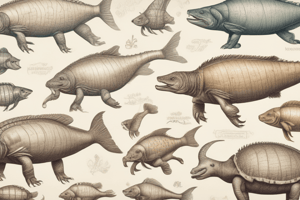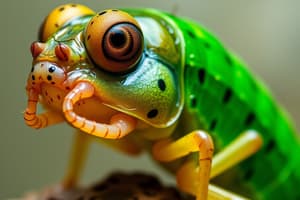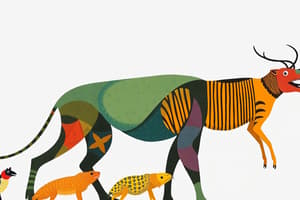Podcast
Questions and Answers
What is the difference between vertebrates and invertebrates?
What is the difference between vertebrates and invertebrates?
Vertebrates have a backbone while invertebrates do not.
Provide two examples of vertebrates.
Provide two examples of vertebrates.
Examples include humans, cats, whales, or birds.
Provide two examples of invertebrates.
Provide two examples of invertebrates.
Examples include snails, bumble bees, crayfish, or earthworms.
Name two basic structural characteristics of a vertebrate.
Name two basic structural characteristics of a vertebrate.
What two things does a backbone help an animal do?
What two things does a backbone help an animal do?
Which classes of vertebrates are warm-blooded?
Which classes of vertebrates are warm-blooded?
What can warm-blooded animals do that cold-blooded animals cannot?
What can warm-blooded animals do that cold-blooded animals cannot?
Why do you think arthropods have segmented bodies?
Why do you think arthropods have segmented bodies?
Match each animal to its corresponding invertebrate group.
Match each animal to its corresponding invertebrate group.
Flashcards
Vertebrates
Vertebrates
Animals with a backbone, internal skeleton, and a nervous system with a brain and spinal cord.
Invertebrates
Invertebrates
Animals without a backbone.
Backbones
Backbones
Support structure that provides shape and protection to vertebrate animals, also used for movement.
Warm-blooded
Warm-blooded
Signup and view all the flashcards
Cold-blooded
Cold-blooded
Signup and view all the flashcards
Mammals
Mammals
Signup and view all the flashcards
Birds
Birds
Signup and view all the flashcards
Arthropods
Arthropods
Signup and view all the flashcards
Exoskeleton
Exoskeleton
Signup and view all the flashcards
Segmented bodies
Segmented bodies
Signup and view all the flashcards
Study Notes
Animal Kingdom Overview
- The animal kingdom is one of the largest kingdoms on Earth
- It contains millions of different species, with thousands more being discovered each year
- Animals are categorized into nine major phyla
Vertebrates vs. Invertebrates
- Vertebrates have a backbone (internal skeleton)
- Invertebrates do not have a backbone
- Both groups have a nervous system (for vertebrates, this includes a brain and spinal cord)
Vertebrate Classification
- Vertebrates include five main classes: mammals, birds, amphibians, fish, and reptiles
- Each class has unique characteristics
Invertebrate Classification
- Arthropods are a major group of invertebrates
- Arthropods have three characteristics; exoskeleton, segmented bodies, and paired jointed appendages
- Some examples of arthropods include arachnids, crustaceans, and insects
Key Animal Characteristics
- Mammals are warm-blooded, nourish young with milk and have hair/fur
- Birds have feathers, are warm blooded and lay eggs , have beaks instead of teeth
- Amphibians are cold-blooded, live in water and on land, and have moist skin
- Fish are cold-blooded, live in water, breathe through gills, and have scales
- Reptiles are cold-blooded animals that lay eggs, have scales or bony plates, and breathe air
- Arachnids (e.g., spiders) lack jaws, usually inject digestive fluids before sucking prey.
- Crustaceans (e.g., crabs) have two pairs of antennae. They have mouths made up of one pair of mandibles and two pairs of maxillae
- Insects (e.g., bees) have three main body parts (head, thorax, and abdomen), three pairs of legs and usually, two pairs of wings. An exoskeleton is a hard, shell-like covering.
Additional Notes
- The provided text suggests online resources, activities, or further study on specific animal classes. Further study is suggested based on the given text.
Studying That Suits You
Use AI to generate personalized quizzes and flashcards to suit your learning preferences.
Related Documents
Description
Explore the vast diversity of the animal kingdom with this quiz that covers key characteristics and classifications. Learn about vertebrates and invertebrates, their unique features, and the major phyla that comprise these fascinating creatures. Test your knowledge on the classifications including mammals, birds, and arthropods.




